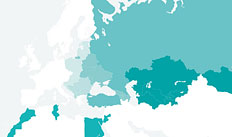Chapter 3
Financial integration without institutional integration
Research and policy experience over the last decade has shown that the gap between institutional integration and de facto financial integration leads to a number of complications which can threaten financial stability – particularly in host countries of multinational banks, but also more broadly. This section summarises the evidence in respect of supervision in normal times, crisis mitigation while banks remain solvent and operational, and resolution.
Subsidiaries of foreign banks are effectively under dual supervision. As domestic entities they fall under host-country authority. In addition, the home-country supervisor has an interest in the health of an entire multinational group if the parent bank is based in that country's jurisdiction. That interest in principle extends to subsidiaries of the group.
In practice, however, the presence of two supervisory authorities can complicate the exercising of effective oversight, and particularly the application of macro-prudential instruments to mitigate credit booms.
- Home-country supervisors may have little incentive (and often no capacity) to police subsidiaries abroad unless they are "systemic" from the perspective of the group (rather than from that of the host country). As long as a subsidiary is relatively small in terms of the parent bank's total capital or operations and if the parent operates a diversified "portfolio" of such affiliates, home supervisors may not pay much attention to lending and risk management practices at the subsidiary level. Unless parent banks are heavily exposed to subsidiaries through longer-term funding, they could just abandon a subsidiary that gets into difficulties,23 although they may have other reasons (for example, related to overall strategy or simply because the subsidiary is potentially profitable) for not doing so.
- Host-country supervisors may not have much information about the parent banks of subsidiaries that operate in their country. Information exchange between national supervisors is mostly difficult and will generally depend on the importance of the host-country operation from the perspective of the whole group. Host supervisors and central banks will also find it more difficult to limit subsidiary lending than lending by stand-alone local banks, as they will have little or no control over parent bank funding. As a result, standard macro-prudential instruments may be insufficient, or may only work if they effectively take the form of capital controls (see Box 3.3). Also, where supervisors manage to limit subsidiary lending, this can be circumvented if international banks replace lending through their subsidiaries with cross-border lending directly from the parent.
These problems could seemingly be addressed through home-host supervisory cooperation, but differences in mandates and incentives are likely to undermine such attempts. For example, when Estonian supervisors petitioned their Swedish counterparts for stricter bank capital requirements during the Baltic boom, the Swedish side felt that there was an insufficient legal basis to increase them for branches or subsidiaries when the group as a whole exceeded the requirements. As a result, host-country authorities often feel that their de facto control over subsidiary lending is quite limited, particularly inside the European Union (where countries cannot interfere with cross-border flows).
Box 3.3 illustrates this by describing the experience of three emerging European countries in the run-up to the crisis.
Where problems come to light in either the home or host country, supervisors will generally have an incentive to either retrieve liquidity behind national borders (particularly when parent banks have extended financing to subsidiaries) or engage in ring‑fencing to prevent liquidity or assets from leaving the country to the detriment of the local financial system. Interfering with the internal capital and liquidity flows of a bank group may have negative externalities on the group as a whole, or parts of it, and give rise to further turmoil.
Home-country supervisors may therefore have an incentive to play down problems at the parent or group level, exacerbating deficiencies in the exchange of information between home and host supervisors that might already exist even in normal times.
The threat of uncoordinated crisis management and communication breakdowns was particularly acute during 2008‑09. Mechanisms that were set up before the crisis (such as the June 2008 Memorandum of Understanding between Financial Supervisory Authorities, Central Banks and Finance Ministries of the European Union on Cross-Border Financial Stability) proved inadequate, prompting the establishment of the European Bank Coordination ("Vienna") Initiative. The aim of the initiative was to agree on home- and host-country crisis management responsibilities and to coordinate the major multinational banking groups in order to prevent a run (since it might have been in the individual interests of banks to withdraw from the crisis-hit region even if it was in their collective interest to avoid rapid outflows).28 The initiative was a success, in part because it received political backing in home and host countries – including a March 2009 EU summit decision that affirmed the right of parent banks to extend official support in their home jurisdictions to their subsidiaries, at least within the European Union – and also because it was monitored by, and had the backing of, international financial institutions. The EU and International Monetary Fund (IMF) supported emerging European countries by lending to governments, while the EBRD and other multilateral development banks supported the subsidiaries of multinational banks in the region.
Since 2011, coordination failures and disagreements between national banking authorities in the European Union can, in principle, be tackled by the EBA, the new EU-level body charged with coordinating and, if necessary, arbitrating between banking supervisors. However, as market pressures on the home countries of several eurozone banks have intensified with the widening crisis in the single currency area, some home and host authorities of these banks have undertaken a series of unilateral and seemingly ring-fencing measures (see Box 3.4). The fundamental cause of these measures is the fact that the responsibility for bank resolution and any associated fiscal losses remains national. In light of this, it is not surprising that EBA coordination has not eliminated ring-fencing and similar unilateral measures.29 Partly in response to these developments, the Vienna Initiative has been revived to foster greater cooperation between authorities and provide a forum for discussions with the multinational banks.30
Home-host coordination is most difficult in the event of the failure of a multinational bank, due to a direct conflict of interest over how to share the fiscal burden of bank resolution. Indeed, it is the anticipation of such a situation that drives the diverging interests of home and host supervisors, both in normal times and during crisis management.
In bank resolution the primary responsibility of national authorities is towards domestic taxpayers, ignoring cross-border externalities (for example, if rescuing the parent bank helps the subsidiary, and vice versa) and instead focusing on minimising local fiscal costs. As a result, too little capital is likely to be invested in a failing multinational bank, as no country will be willing to pay for the positive externalities accruing to others. This may make it difficult to maximise the bank's value as a going concern, and may also induce outcomes that are both inefficient and detrimental for systemic stability – such as a break-up and separate nationalisation when the bank would have more value, in a future reprivatisation, as a single entity.31
A legislative proposal by the European Commission (EU framework for bank recovery and resolution, June 2012) proposes to address some of these problems by creating "resolution colleges", analogous to the supervisory colleges chaired by the EBA, and giving the EBA a mediation role between the national authorities sitting on these colleges. However, the EBA's scope for resolving conflicts of interest in this area would remain constrained by Article 38 of the EBA regulation, which compels it to "ensure that no decision adopted pursuant to [actions in emergency situations and settlement of disagreements between national authorities in cross-border situations] impinges in any way on the fiscal responsibilities of Member States." This means that it will not be able to take a decision on a bank resolution issue that determines how fiscal losses are distributed across countries which, unfortunately, is likely to be the main source of disagreement among national authorities.
Given this constraint, the most promising way to address resolution-related conflicts between countries may be to set up ex ante burden-sharing arrangements – as envisaged, in principle, by the cooperation agreement on cross-border financial stability, crisis management and resolution signed between the three Baltic states and five Nordic countries in August 2010 (see Box 3.5).
Alternatively, if countries are not willing to tie their fiscal hands, the next-best solution may be to ring-fence subsidiaries of multinational banks in each country ex ante – that is, a multinational's subsidiaries would manage their capital and liquidity in each country separately from each other and from the parent. In this case, a solvency or liquidity problem in one unit (a subsidiary or the parent) within a group would not, in general, threaten the solvency or liquidity of another, and could be resolved nationally without any international burden sharing. However, this would come at a potentially significant efficiency cost in normal times. In particular, the sum of ring-fenced pools of capital would need to be larger than the existing group capital, as banks could no longer exploit the benefits of international diversification. It would also imply that multinational banks could no longer serve as a conduit for lending deposits or savings from one country in another – a function which, while going too far during the 2005-08 credit boom in emerging Europe, can be a driver of investment and growth in the recipient countries.32
23 For instance, when Riječka banka – the Croatian subsidiary of Bayerische Landesbank – suffered large currency losses in 2002 the parent did not rescue it.
28 On the Vienna Initiative, see: EBRD (2009), Box 1.4; Bakker and Klingen (2012), Box 5.2; and Pistor (2011). The impact of the initiative is analysed empirically in Cetorelli and Goldberg (2011) and De Haas et al. (2012).
29 Of course, it is possible (indeed, likely) that the presence of the EBA and/or EU rules on the free movement of capital prevented more drastic unilateral measures than those which materialised during 2011-12.
30 The Vienna Initiative 2.0 was launched in the spring of 2012. A Full Forum meeting with representatives from the national authorities, the international institutions and the main cross-border financial institutions adopted a set of guiding principles for home-host coordination. See: http://ec.europa.eu/economy_finance/articles/governance/2012-03-13-ebci_en.htm.
31 See Freixas (2003) and Goodhart and Schoenmaker (2009). The fragmentation of the financial conglomerate Fortis, systemically important in Belgium, the Netherlands and Luxembourg, is an example of how limited supervisory cooperation during an acute crisis may result in suboptimal outcomes.
32 See Friedrich et al. (2012). Historic examples of sustained growth episodes driven by capital inflows episodes include Canada in the late 19th century, the Scandinavian countries in the late 19th and early 20th century, and west European income convergence after the Second World War. See EBRD (2009), Box 3.1.







